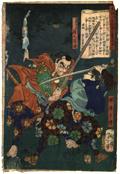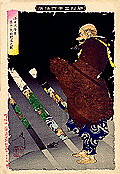A tengu mask from a souvenir store at Kibune, northern Kyoto. Kibune
is located near Mount Kurama, a legendary hideout for tengu
demons.
When Wayne Muromoto handed me the
inaugural issue of Furyu, I immediately noticed the name and logo of
his publishing company, Tengu Press Hawaii, which is shown at the bottom
center of the front cover.
I have always been interested in Japanese mythology and had recently been
researching the subject of tengu, which means "heavenly dogs", for an upcoming
novel.
There are actually two forms of tengu. The first and more ancient type,
karasu or "crow" tengu, has the beak, claws, and wings of a bird but the body
of a man. The logo for Tengu Press Hawaii depicts the head of a bird tengu
wearing a small round priest's cap. Yamabushi or "mountain priest" tengu are
probably more well known. They take the form of barefooted elderly mountain
priests with extremely long noses. Wooden masks of both types of tengu are
popular. In English, the term tengu merely translates as "goblin" without
distinction as to the two forms.
The Heavenly Dogs of China
So what does the term "heavenly dogs"
have to do with birdmen or long nosed priests? The Chinese have a legend about
mountain demons called t'ien-kou, the written characters for which mean
heavenly or celestial dog. Those same characters are pronounced "tengu" in
Japanese. I was at first surprised to learn that the Chinese t'ien-kou derived
their names from comets or meteors-heavenly bodies falling to earth, the
trails of which resemble the tails of dogs or foxes. In other words, they are
starry, or "astral," beings. This piqued my curiosity because I am also very
interested in astral projection or out of the body travel.
T'ien-kou legends found their way to Japan in the sixth and seventh
centuries. Early tengu, like the t'ien-kou, were evil birdlike demons which
did many foul deeds such as kidnapping and eating children, starting fires,
and misleading priests. They could also transform themselves into the form of
men, women or children.
Since they lived in the mountains, tengu often took the form of the
eccentric yamabushi (mountain priests) who also lived there. Many yamabushi
were thought to possess magical powers derived from their ascetic practices
and the sacredness of the mountains themselves. Over time, the folklore of
tengu and yamabushi became intertwined. The yamabushi form of tengu became
most popular and even the bird tengu were shown wearing the short robes and
caps of priests. Tengu were also portrayed as being more mischievous than evil
and were often depicted helping people.
The characteristics of tengu are diverse and depend largely on historical
perspective. Remember that tengu originated as evil demons which evolved over
the centuries into mischievous, but often helpful, mountain spirits taking
either birdmen or mountain priest forms. The following is a brief
sampling.
Tengu Tales
Tengu are born from giant eggs and live in the
mountains. Bird tengu congregate in high trees. In their last incarnation as
humans, tengu were arrogant samurai or priests-that is why they have beaks or
long noses. The expression tengu ni naru is thus an admonition to avoid being
arrogant. If they do good deeds, however, tengu can be reborn as humans.
Tengu, unlike obake (ghosts), are always shown with feet. Yamabushi
tengu usually have extremely wrinkled feet to show their old age.
The wings of bird tengu are usually shown with ordinary feathers. However,
some authorities describe the wings as shimmering, like those of a
hummingbird. This would be in keeping with their heavenly origin.
As mentioned earlier, tengu can take human form, usually to trick people.
Tanuki (badgers) and kitsune (foxes) have the same power but their true forms
are revealed by their shadows or reflections. Thus, a kitsune which has taken
the form of a beautiful woman will often be depicted casting the long nosed
shadow of a fox. I suspect that the true forms of tengu would be similarly
revealed. If a tengu is struck down by magic or a powerful martial artist, it
will often transform into a wounded blackbird.
Tengu speak without moving their mouths, as if by telepathy. They can also
possess and speak directlythrough people as well as appear to them in
dreams.
Tengu apparently have a hierarchy. Long nosed tengu are generally in charge
of bird tengu. The king of all tengu is Sojobo, an elderly, white-haired
yamabushi tengu. Sojobo is famous for teaching martial arts and strategy to
Minamoto Yoshitsune on Mt. Kurama, north of Kyoto.
Tengu In Art
Much of what we know about the appearance of tengu
comes to us from the Japanese ukiyoe (woodblock print) artists. They often
depicted famous Japanese legends and stories, many of which involved tengu. I
personally am very fond of the artist Yoshitoshi Tsukioka (1839-1892) and his
teacher Kuniyoshi Utagawa
(1797-1861). Both depicted many martial arts scenes with stunning realism,
including the training of Yoshitsune by Sojobo, and Yoshitsune's famous fight
with the monk Benkei on the Gojo Bridge in Kyoto. In both instances, Sojobo is
shown teaching or aiding his pupil, assisted by several bird tengu.

In this detail of a woodblock print by Yoshitoshi, the martial arts
master Tsukahara Bokuden receives divine instruction in the art of fencing
from a mysterious yamabushi (mountain priest) tengu named Enkai of Haguro
Mountain. (Print from the collection of Charles C. Goodin and featured at the
Yoshitoshi Ukiyo-e Web Gallery in the
Eastern Brocade Series)
Although Yoshitsune's encounter with tengu is probably the most well known
folktale, other interesting depictions also exist. In my personal collection,
I have a woodblock showing a fight between Tsukahara Bokuden and the yamabushi
tengu Hinamaru Enkai. The print is from a series published in 1867 entitled Tales of the Floating World on Eastern
Brocade (Azuma No Nishiki Ukiyo Kodan).
In the print, the tengu towers over his adversary wielding an octagonal bo
(staff). In a stylized manner, he is shown with an elongated nose and the garb
of a mountain priest including bare feet and a small black cap which can also
serve as a drinking cup. Martial artists will recognize the poses, hand
positions and stances.
What might be difficult to recognize is the light colored vertical shape to
the right rear of the tengu. Similar designs are sometimes shown in prints
depicting obake (ghosts) and other mythological creatures such as oni
(demons), tanuki (badgers) and kitsune (foxes). Tanuki and kitsune, like
tengu, can transform into human form. Given the white trail behind the tengu,
I suspect that he might have just descended upon his human opponent.

The tengu of Mout Hiko appears out of the mist to enlighten the
swordsman Kobayakawa Takakage, in this print by Yoshitoshi. (Print featured at
the Yoshitoshi Ukiyo-e Web Gallery in
the Ghost Series)
In another print by Yoshitoshi from the series entitled New Forms of
Thirty-Six Ghosts which was published just before the artist' s death, the
Tengu of Mt. Hiko appears out of the mist to Kobayakawa Takakage (1532-97) on
the island of Kyushu. The print is reprinted below with permission from the
San Francisco Graphic Society from the book Yoshitoshi's Thirty-Six Ghosts by
John Stevenson.
What I found most interesting was that the scene was shown from the tengu's
perspective, that is, from his side of the mist. Through breaks in the mist,
Kobayakawa can be seen sitting composed ready to receive the tengu's message
while his men recoil in fear. The tengu is standing with bare feet wearing
garb similar to that shown in the earlier print.
Tengu and Esoteric Beliefs
This is where my interest in astral
projection ties in. I asked my mother (who is from Fukuoka) to discuss the
issue of tengu with her friend, an elderly and well-educated woman from Japan.
She confirmed many of the things I had previously read about tengu, and then
added that tengu do not fly from place to place. Instead, they disappear at
one location and instantly appear at another. I suppose that is one reason
they are barefoot-they have no need for shoes.
Winged creatures that fly, long nosed priests that magically materialize,
it all sounds familiar, doesn't it? Tengu legends have many parallels or
similarities to other world myths and legends. Angels have wings to fly
between heaven and earth, as did the Greek god Hermes (Mercury), although his
wings were on his sandals and cap. In Hawaiian, Egyptian and many other
religions, man's spirit is depicted as a bird. The image of a bird perched on
a staff is often associated with leaving the body. The list is practically
endless.
Anyone who has practiced meditation will have experienced the sensation of
floating "out," or at least will have heard about it from friends or teachers.
In viewing Yoshitoshi's print of the Tengu of Mt. Hiko, I am certain that he
knew how it felt to be in the mist-the gray atmosphere sometimes passed
through when out of the body. He must have personally experienced the
supernatural to have depicted the mythology of the day in such novel and
creative ways.
In fact, Yoshitoshi suffered from mental illness during the last few years
of his life. It was during this period that he designed the Thirty-Six Ghosts
series. He died three weeks after being discharged from a mental hospital at
the age of 53.
The value of myth is not so much in the folksy details but in what the myth
represents. I find many correlations between Japanese mythological
beings/creatures and subjects such as astral projection. Whether tengu appear
on wooden masks, in woodblock prints, in your dreams, or out of the mist, they
are an intriguing part of Japanese mythology.
Note: The author welcomes your comments and stories on the general
subject, especially as it relates to budo.
References:
- Japanese Ghosts Demons: Art of the Supernatural, edited by
Stephen Addiss, George Braziller, Inc., 1985.
- Yoshitoshi's Thirty-Six Ghosts, John Stevenson, University of
Washington Press, 1983.
- Beauty and Violence: Japanese Prints by Yoshitoshi, Eric van den
Ing and Robert Schaap, Society for Japanese Arts, 1992.
Charles C. Goodin is an instructor at the Aiea Matsubayashi Karate Dojo
in Aiea, Hawaii. He is an attorney, writer, and the publisher of the Yoshitoshi Ukiyo-e Web Gallery and the Kuniyoshi Ukiyo-e Web
Gallery.